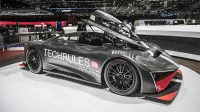Techrules preparing turbine-powered PHEVs for passenger vehicles this year

The timeline is undoubtedly egregiously optimistic. When Techrules first debuted the AT86 and GT86 in 2016, the company said it hoped to secure a European site for micro-turbine production by the end of that year. Three years later, Techrules is still working on breaking ground somewhere.
That doesn’t mean the TREV won’t happen eventually, and we’re rooting for it. The latest Ren supercar used a two 80-kW turbines, but Techrules plans a 15-kW turbine setup for passenger vehicles. The original GT86 concept was closer to the production solution. In the GT86, a 36-kW turbine sent 30 kW to a 20-kWh lithium-manganese-oxide battery, and the other six kilowatts powered ancillaries like the inverters. Techrules said the battery could be fully charged in 40 minutes by the turbine system thanks to its proprietary battery management software.
In detail, Techrules developed a non-contact bearing system using air and magnets to allow the turbine to spin at 96,000 rpm. The bearing system reduces frictional losses and allows even higher rpm than 96,000; the high spin cycle increases turbine efficiency. A shaft off the micro-turbine is connected to a generator that recharges the battery. Techrules said that the turbines run on diesel or biogas, and its system is roughly 50 percent more efficient as a range-extender than a piston engine is. The company said its 1,287-horsepower Ren RS track car with a 28-kWh battery could go 727 miles on about 21 gallons of diesel.
Turbine range-extenders are already in use for some commercial vehicles — New Zealand has put them in buses, and Mack demonstrated a plug-in hybrid garbage truck. If Techrules can get the turbine thing going for passenger cars, it will close a circle opened in the 1950s when European and American OEMs — Chrysler, most famously — experimented with turbines. And it will make a Jaguar C-X75 possible, which, of course, is our only real interest in this.
Related Video:




